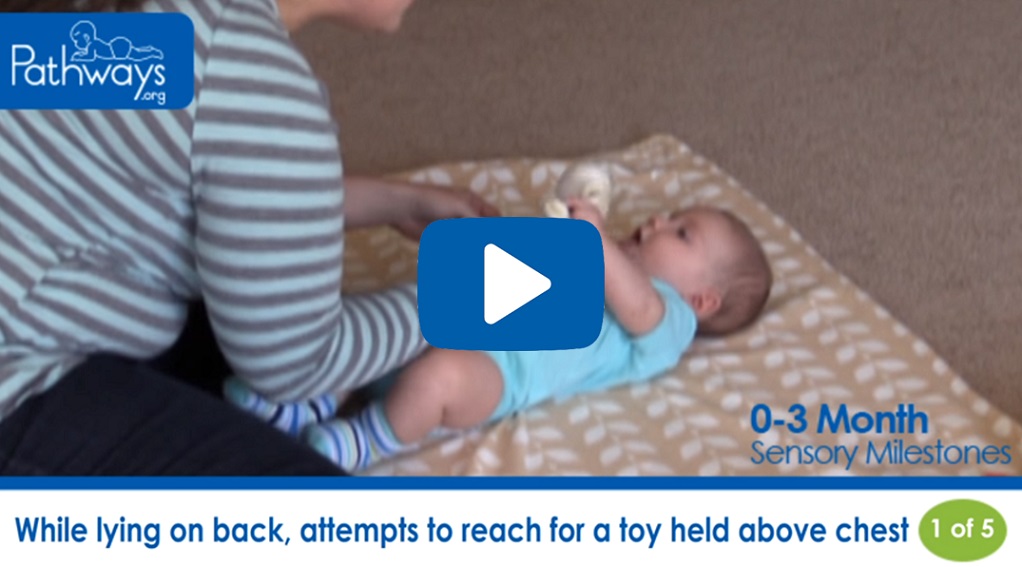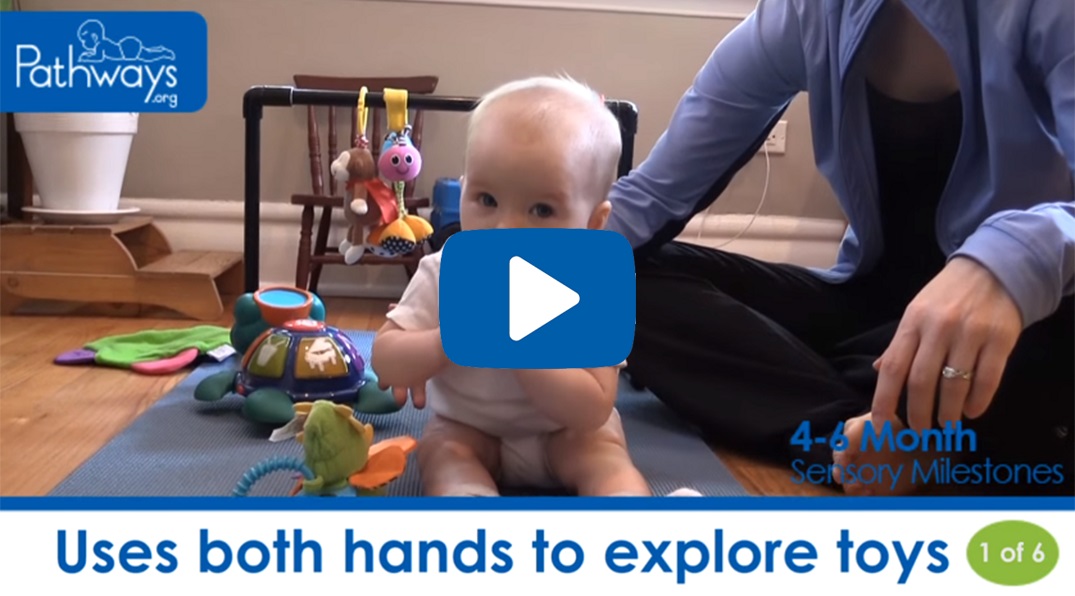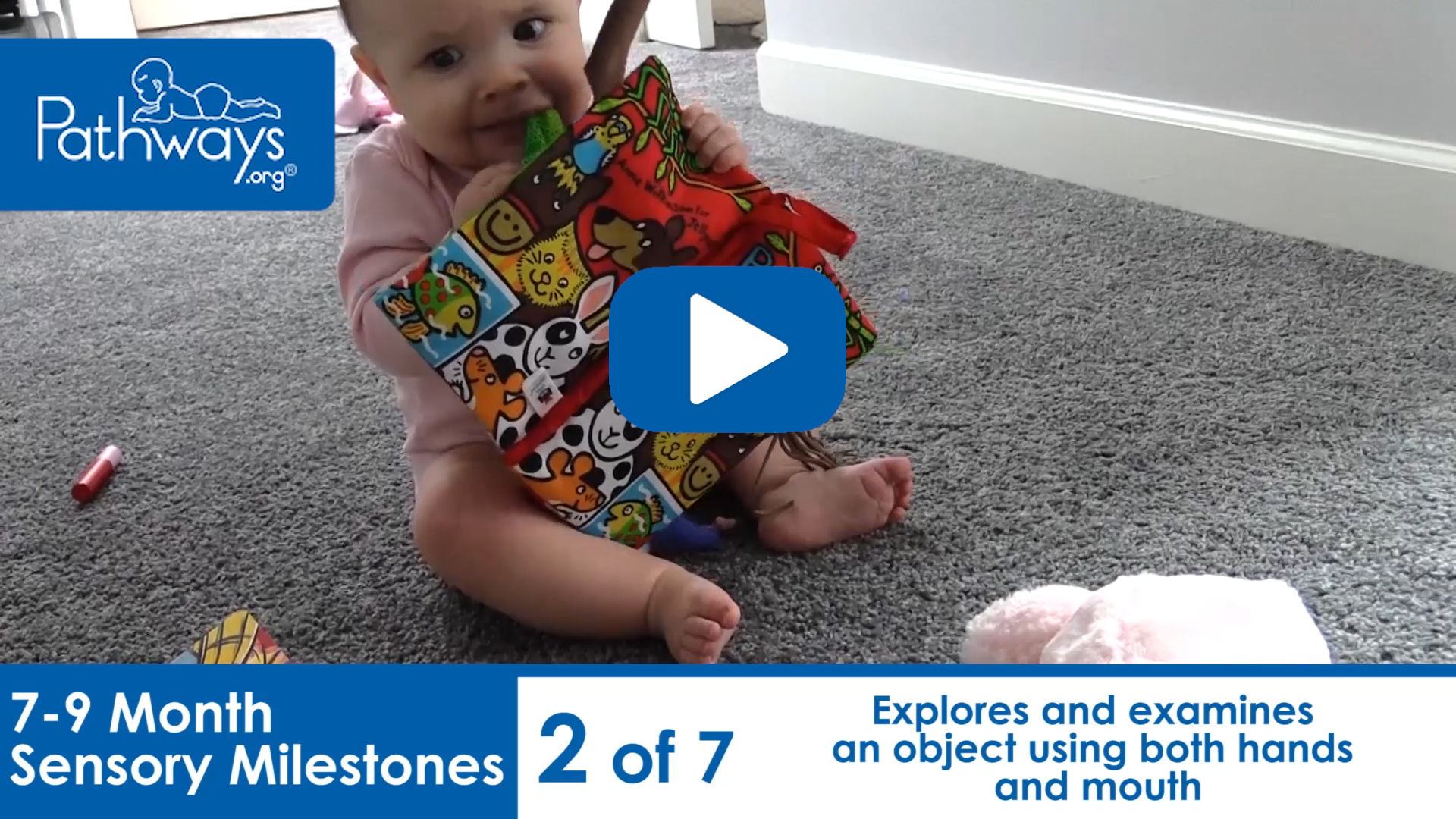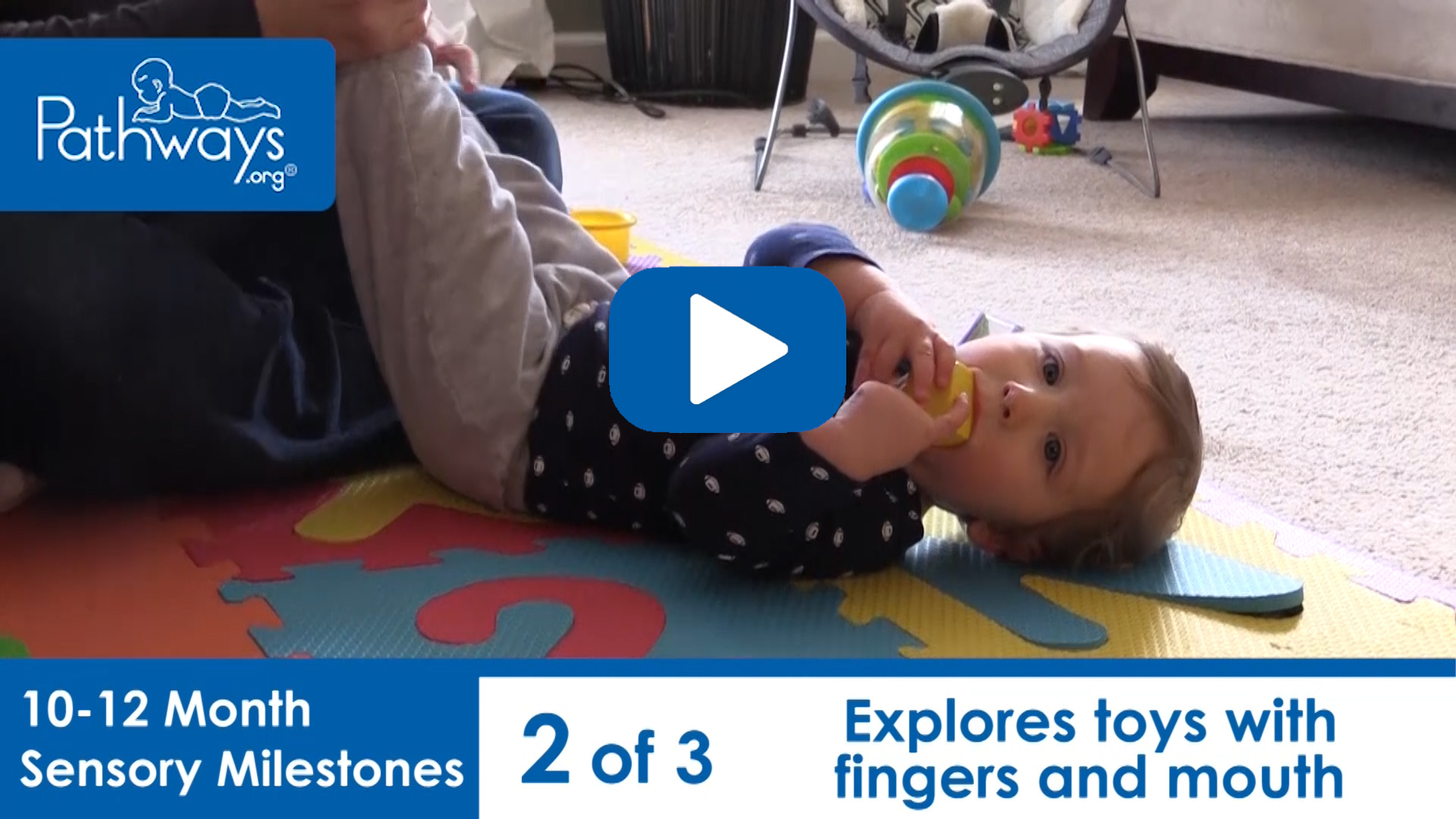Tracking Sensory Development
Examine the milestones listed below to track your child’s sensory development. Remember, if you have a concern talk with your healthcare provider and ask for an evaluation.
0-3 Months
- While lying on back, attempts to reach for a toy held above their chest
- While lying on back, visually tracks a moving toy from side to side
- While lying on back, keeps head centered to watch faces or toys
- Able to calm with rocking, touching, and gentle sounds
- Enjoys a variety of movements
4-6 Months
- Uses both hands to explore toys
- Generally happy when not hungry or tired
- Brings hands and objects to mouth
- Able to calm with rocking, touching, and gentle sounds
- Is not upset by everyday sounds
- Enjoys a variety of movements
7-9 Months
- Enjoys a variety of movements – bouncing up and down, rocking back and forth
- Explores and examines an object using both hands and mouth
- Turns several pages of a chunky (board) book at once
- Experiments with the amount of force needed to pick up different objects
- Focuses on objects near and far
- Investigates shapes, sizes, and textures of toys and surroundings
- Observes environment from a variety of positions – while lying on back or tummy, sitting, crawling, and standing with assistance
10-12 Months
- Enjoys listening to songs
- Explores toys with hands, fingers, and mouth
- Crawls to or away from objects baby sees in the distance
13-18 Months
- Helps with getting dressed/undressed
- Has a regular sleep schedule
- Eats an increasing variety of foods
If you are concerned about your child’s sensory development, record your observations on the Ability Checklist and discuss your concerns with your child’s healthcare provider. Occupational therapy can help children develop the sensory skills they need to reach their fullest potential.
This information is for parents and professionals interested in understanding more about the sensory systems and the importance of the 7 senses in baby’s first year. Use these resources to keep track of your baby’s sensory milestones and have fun with games and activities appropriate for their developmental stage.1
Development at 0-3 Months
At this age, baby is constantly receiving information through all their senses and using these senses to learn and grow every day.
Consistent caregiver responsiveness is essential at this age – it helps baby to learn about their body, their immediate world, and their early social relationships.
Vestibular Sense (Movement and Balance Sense)
The vestibular sense gives information about where our head and body are in space, allowing us to stay up right while we sit, stand, and walk.
What to expect
- Arms open outward when baby is tilted backward (Moro reflex)
- Starts to hold head up with less support, lift head while on tummy, shows more head control when pulled to a sit
- Follows moving objects with their eyes
- Begins to support some weight on their legs when held upright, even though they will not be ready to stand for many months
- Turns head towards breast or bottle for feeding or away from a bright light
Activities to promote development
- Hold baby in a variety of positions
- Give baby supervised tummy time
- Pay attention to baby’s responses to various types of motions and positions. This will help to provide comforting types of movement and expand the types of movements baby enjoys
- Rock and sway with baby
- Pull to sit while interacting with baby face-to-face
- Head turning with body going over as in early rolling
Proprioception (Body Position Sense)
Proprioception tells us where our body parts are relative to each other and gives us information about how much force to use for different activities.
What to expect
- Stretches and burrows head into caregivers’ chest
- Learns to use mouth muscles to suckle on breast or bottle
- Imitates facial actions – sticks out tongue or begins to smile
- Momentarily bears weight on their feet when held upright – sets the stage for walking nearly a year later
- Moves head towards voice or light
Activities to promote development
- Move baby’s hands together, feet together, and across midline during bath time or dressing
- Face-to-face play with baby in support position
- Tummy time with baby lifting head
- Carry baby in different positions
Tactile Sense (Touch)
The tactile sense gives us information from our skin. When we touch something or are touched, we receive information about shape, size, texture, pressure, and temperature.
What to expect
- Able to calm when enveloped in arms or in a blanket
- Skin-to-skin contact important
- Reflexes – baby grasps at fingers or turn head towards cheek that is brushed
- Shows startle response
Activities to promote development
- Provide loving, comforting contact – skin-to-skin contact makes them feel connected and safe
- Daily massage
- Bath time, dressing, and changing diapers offer opportunities for sensory input – lotions, oils, different textured fabrics
- Introduce different textures through toys, blankets, and towels
Olfactory and Gustatory Senses (Smell and Taste)
What to expect
- Anticipates feeding and orients to the smell of their caregiver / milk
- Shows preference for pleasant smells (vanilla) and dislike for pungent odors (spoiled food)
- Babies are born with preferences for the types of smells and tastes they experienced from the foods their mothers ate during pregnancy; these preferences continue for breastfed babies
Activities to promote development
- Create pleasant, calm, and comforting experiences alongside pleasant scents. This will lay foundations for positive associations
Auditory Sense (Hearing)
What to expect
- Turns to sound of a sibling or pet
- Calms when caregiver talks in a sing-song voice
- Cries when startled
- Coos in response to face-to-face contact
Activities to promote development
- Play music
- Dance and sing with baby (face-to-face contact)
- Let baby play with squeaky toys / toys that make noise
- Narrate your day
- Coo, talk, and smile with infant (face-to-face contact)
Visual Sense (Sight)
What to expect
- Sees clearly at a distance of about 1-2 feet – perfect for facial engagement
- Turns head away from light
- Interested in faces, starting to make eye contact
Activities to promote development
- Give lots of face-to-face contact – let them watch your face while you talk or sing to them
- Carry baby at shoulder height so they can look at where they are going
- Carry baby as you go about daily routine
Interoceptive Sense (Senses of Pain, Hunger, and Temperature)
What to expect
- Generally in a calm, alert state
- Cries when uncomfortable – hungry, tired, diaper change,
- Needs caregivers to help regulate body temperature
Activities to promote development
- Give baby physical contact and warmth
- Adjust lighting to help baby stay alert or calm down for a nap
- Give frequent diaper changes
- Take baby outside into the fresh air
Development at 4-6 Months
At this age, baby is constantly receiving information through all their senses and using these senses to learn and grow every day.
Consistent caregiver responsiveness is essential ate this age- helps babies learn about their bodies, their immediate world, and their early social relationships.
Vestibular Sense (Movement and Balance Sense)
The vestibular sense gives us information about where our head and body are in space, allowing us to stay up right while we sit, stand, and walk.
What to expect
- Gains greater head control – can hold head and chest upright during Tummy Time
- Rolls from tummy to back, and may roll from back to tummy by the end
- By 6 months – sits with support
- Can use both sides of the body together – claps, bangs toys together
- If moved forward, baby will put hands out in front
- Transfers toy from one hand to the other
- Can push up on forearms
Activities to promote development
- Carry and play with baby in different positions
- Dance with baby
- Use slow back and forth movement – hammock, rocking chair – for calming and more vigorous motion for play
Proprioception (Body Position Sense)
Proprioception tells us where our body parts are relative to each other and gives us information about how much force to use for different activities.
What to expect
- Rolls over
- Bring hands together and make faces
- Rocks back and forth and side-to-side on all fours
- Holds their own bottle
- Experiments with force – pulls blankets down, pets animals, claps, etc.
Activities to promote development
- Let baby explore on the floor on both back and tummy to develop muscles
- Spend face-to-face time together, making lots of faces and vocalizations
- Provide gentle push and pull actions in playful ways
- Help move baby through actions, like patty cake or petting an animal
Tactile Sense (Touch)
The tactile sense gives us information from our skin. When we touch something or are touched, we receive information about shape, size, texture, pressure, and temperature.
What to expect
- Soothed by soft, cozy sensations – blanket, clothes, toys
- Enjoyment of touch motivates movement and exploration
- Reaches for objects, puts objects in mouth
Activities to promote development
- Introduce new sensations with lotion, oils, fabrics
- Provide a variety of textured hand-held toys and surfaces – blankets, play mats, sponges, balls
- Continue to provide plenty of skin-to-skin contact
Olfactory and Gustatory Senses (Smell and Taste)
What to expect
- Starts to show interest in smells and look of foods that others are eating
- Anticipates feeding by smell of caregiver
- Normal reactions to unpleasant odors
Activities to promote development
- Facilitate positive associations between pleasurable scents and experiences
- Remove strong odors from the environment
Auditory Sense (Hearing)
What to expect
- Turns head towards sounds
- Notices toys that makes sounds
- Coos at caregiver…may start babbling around 6 months
- Differentiates cries for different needs
Activities to promote development
- Talk to baby frequently – narrate your day
- Imitate and engage in vocal play with baby
- Listen to music together
- Point out objects while you talk
Visual Sense (Sight)
What to expect
- Interested in faces, imitating facial expressions
- Tracks objects and people moving across the room
- Looks around while sitting with support
Activities to promote development
- Provide opportunities for baby to see a variety of people and things
- Hold baby face-to-face while you talk and make silly faces
- Carry baby around and point out objects while you name them
Interoceptive Sense (Senses of Pain, Hunger, and Temperature)
What to expect
- More predictable daily rhythm – gets hungry and requires naps at more predictable times
- Protests to being put down or handed off to another adult
- Shows signs of discomfort – cry, general fussiness, turning away
Activities to promote development
- Help facilitate circadian rhythm – take baby out in natural light during the day and reduce lighting at night
- Breastfeeding mothers – be mindful of the food you consume
- Meet baby’s needs – naps, sleep, diaper changes, hunger – helps them feel secure in knowing that they can have their needs met
Development at 7-9 Months
At this age, babies start to move around on their own and enjoy exploring new textures, movements, and environments. They are constantly receiving information through all their senses and using these senses to learn and grow every day. Use our resources to keep track of your baby’s sensory milestones and have fun with games and activities appropriate for his or her developmental stage.
Vestibular Sense (Movement and Balance Sense)
The vestibular sense gives us information about where our head and body are in space, allowing us to stay up right while we sit, stand, and walk.
What to expect
- Shows more control while rolling, sitting, and scooting
- Starts to crawl and stand
- Tries to lean towards, reach for, and throw toys
- Enjoys a variety of movements – bouncing up and down, rocking back and forth
Activities to promote development
- Walk with baby in a carrier or baby backpack
- Play with baby in many different positions
- Take baby out in a baby seat, stroller, or jogger
- Use slow, rocking motions for calming and more vigorous motions for play time
- Give baby space to move around, but stay close by to maintain sense of security
Proprioception (Body Awareness Sense)
Proprioception tells us where our body parts are relative to each other and gives us information about how much force to use for different activities.
What to expect
- Able to stretch, reach, and lean in many directions
- Can hold a bottle and place pacifier in mouth
- Experiments with amount of force used to pick up different objects
Activities to promote development
- Create a safe environment for baby to move around and explore – cover electrical outlets, install safety gates, and keep dangerous items out of reach
- Carry baby in new positions – for example, on shoulders or up in the air
- Introduce toys and games that involve pushing and pulling, such as toy cars or wagons
- Give baby time to sit independently to develop neck, back, and stomach muscles
Tactile Sense (Touch)
The tactile sense gives us information from our skin. When we touch something or are touched, we receive information about shape, size, texture, pressure, and temperature.
What to expect
- Investigates shapes, sizes, and textures of toys and their surroundings
- Uses hands, mouth, and face to explore objects
- Picks up small objects with thumbs and fingers
Activities to promote development
- Introduce new textures while baby is eating, sleeping, dressing, or playing outdoors
- Use a variety of sponges, soaps, and lotions during bath time
- Provide plenty of skin-to-skin contact with a parent or caregiver
Olfactory and Gustatory Senses (Smell and Taste)
What to expect
- Starts to look at and reach for food that is nearby
- Shows strong reactions to new smells and tastes
- Begins to form associations with familiar smells and tastes
Activities to promote development
- Place pleasant smells, such as vanilla, almond, or citrus, in baby’s play, living, and sleeping areas
- Introduce new foods gradually and watch for baby’s response
- Do not force food or show stress over a baby’s dislike for certain foods
- If baby refuses a certain food item, try changing the texture
Auditory Sense (Hearing)
What to expect
- Can distinguish between familiar and unfamiliar voices
- Shows recognition of commonly used words
- Uses a few different sounds when babbling
Activities to promote development
- Respond to baby’s sounds and encourage two-way communication
- Describe your actions as you dress, feed, and bathe baby – gives him or her an opportunity to listen to the sounds and rhythms of your speech
- Read picture books together to help baby connect words to images
- Play music throughout the day – lively, upbeat music during playtime, and quiet, melodic music for naps and bedtime
Visual Sense (Sight)
What to expect
- Able to focus on objects both near and far
- Mimics facial expressions and gestures
- Shows interest in where others are looking or pointing
- Observes environment from a variety of positions – while lying on back or tummy, sitting, crawling, and standing
Activities to promote development
- Give baby frequent face time
- Point out objects while you walk and talk with baby
- Encourage baby to play on the floor with toys of various colors, sizes, and shapes
- Allow baby to grab and explore items within reach
Interoceptive Sense (Senses of Pain, Hunger, and Temperature)
What to expect
- Craves chew toys that can massage sore and swollen gums during teething
- Feels full longer after eating more solid foods
- Increased anxiety after time away from caregivers
Activities to promote development
- Provide baby with a healthy diet – avoid artificial ingredients, sugars, and preservatives
- Help baby establish a consistent sleep schedule
- Change diaper frequently
- Provide plenty of skin-to-skin contact to comfort baby
Development at 10-12 Months
At this age, babies begin to show preferences of where to go, what to touch, and how they are carried. They are increasingly mobile and enjoy exploring new environments. Use our resources to keep track of your baby’s sensory milestones and have fun with games and activities appropriate for his or her developmental stage.
Vestibular Sense (Movement and Balance Sense)
The vestibular sense gives us information about where our head and body are in space, allowing us to stay up right while we sit, stand, and walk.
What to expect
- Able to crawl, stand, shift weight, and cruise along furniture
- May start to walk independently
- Enjoys more energetic activities – for example, dancing or horseback riding on a parent’s back
- Can look around while body is in motion
Activities to promote development
- Provide push toys that allow baby to practice walking with some support
- Encourage baby to dance and sway to music
- Provide opportunities to experience slow, rocking movements – for example, swinging on a hammock
Proprioception (Body Awareness Sense)
Proprioception tells us where our body parts are relative to each other and gives us information about how much force to use for different activities.
What to expect
- Puts arms and legs into, under, and over new spaces and objects – for example, may crawl under tables or into cupboards
- Climbs on and off cushions, small toys, and carpeted stairs
- Cranes neck to see around a corner or other obstacle
Activities to promote development
- Create a safe space where baby can explore while sitting, standing, and crawling
- Encourage baby to play with push and pull toys that require different amounts of force
Tactile Sense (Touch)
The tactile sense gives us information from our skin. When we touch something or are touched, we receive information about shape, size, texture, pressure, and temperature.
What to expect
- Increases interaction with small objects
- Enjoys different textures from food, blankets, mud, paint, etc.
- Explores toys with fingers and mouth
Activities to promote development
- Introduce baby to new textures through food, toys, clothes, sponges
- Name textures, shapes, and sizes to help baby attach words to tactile experiences
- Provide plenty of skin-to-skin contact with caregivers
Olfactory and Gustatory Senses (Smell and Taste)
What to expect
- Enjoys a greater variety of smells and tastes
- Has more teeth and better control of tongue and lips
- Ready to try soft-cooked vegetables, soft fruits, and finger foods (e.g. teething biscuits, pasta)
- Might be ready to start spoon feeding
Activities to promote development
- Provide safe environments for baby to experience new smells and tastes
- Keep baby away from areas where people are smoking or using harsh chemicals
- Keep track of what your baby is eating – well-meaning friends and family members may give baby food inappropriate for his or her age
Auditory Sense (Hearing)
What to expect
- Understands many familiar sounds and words
- Enjoys listening to songs
- Points and gestures with sounds to communicate wants and needs
- Crawls towards or away from sounds coming from a distance
Activities to promote development
- Describe your actions throughout the day as you dress, feed, and bathe baby
- Respond to baby’s sounds to encourage two-way communication
Visual Sense (Sight)
What to expect
- Able to look around while sitting or standing without falling over
- Can spot things at a distance – may crawl towards or away from things
Activities to promote development
- Point out objects while you talk
- Make consistent gestures that baby can see and interpret
- Show baby where things go so that he or she can find them again
Interoceptive Sense (Sense of Pain, Hunger, Temperature)
What to expect
- Teething may cause swelling, pain, and general fussiness
- Frequent diaper rashes
- Experiences stomach aches, constipation, and diarrhea from new food in diet
Activities to promote development
- Provide a predictable but flexible daily routine
- Provide baby with a variety of nutritional and age-appropriate food
- Carry baby throughout the day to reduce stress and maintain sense of security
- Control lighting at home during the day and night
- Respond to baby’s distress signals



